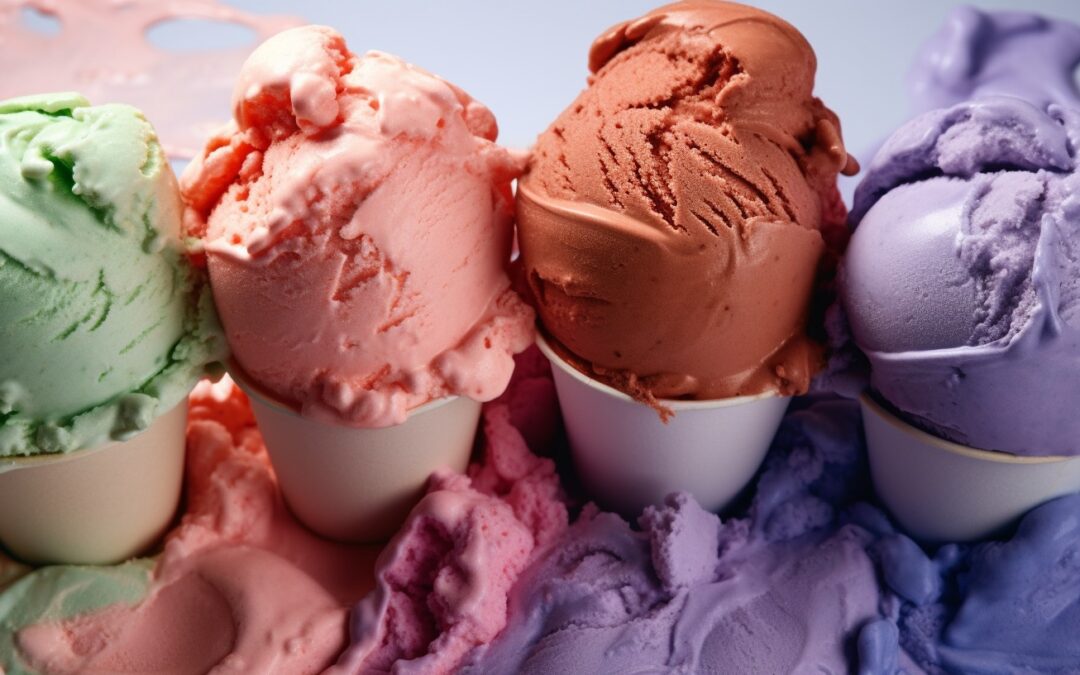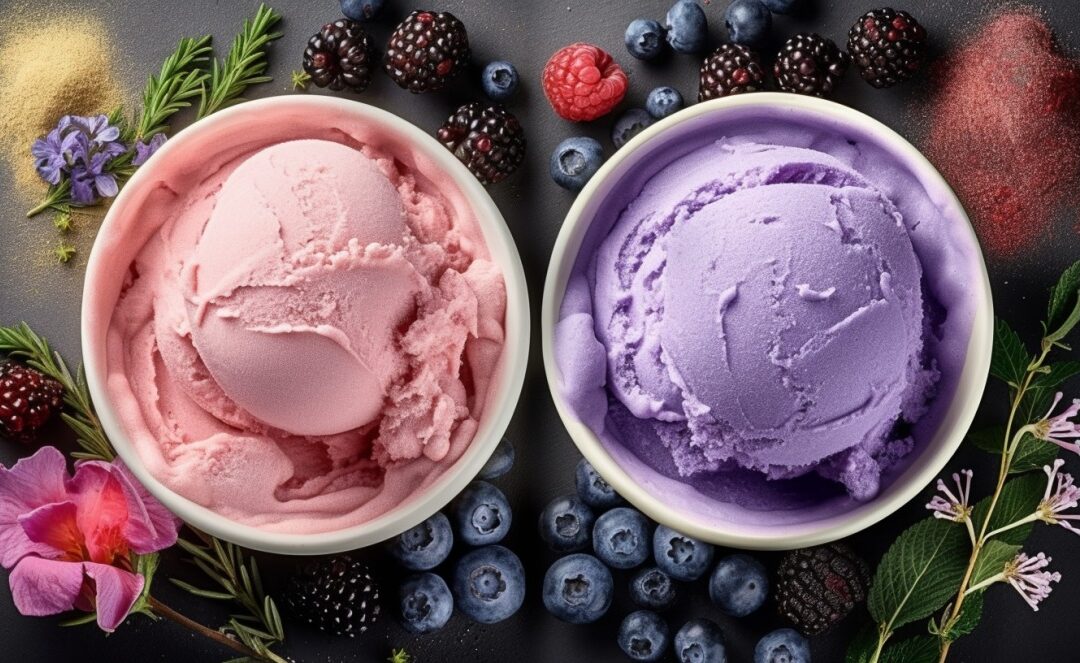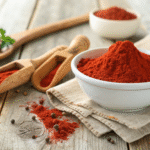
by admin | Jul 8, 2023 | Blog
INTRODUCTION
In recent years, consumers have become more conscious about the ingredients in their food, seeking healthier and more natural alternatives. This trend has had a significant impact on the ice cream industry, particularly in the realm of colorings. Traditionally, artificial colors have been used to create vibrant and appealing ice cream hues, but the demand for natural and clean-label products has led to a surge in natural color innovations. In this blog post, we will explore natural color Innovations: trends and future possibilities In the ice cream Industry
THE SHIFT TOWARDS NATURAL COLORS
Consumers are increasingly concerned about the potential health risks associated with artificial food additives, including synthetic colorings. As a result, there has been a growing preference for natural and plant-based ingredients. Natural colors, derived from fruits, vegetables, and other botanical sources, have gained traction as a safer and more appealing option for ice cream manufacturers and consumers alike.
Ice cream manufacturers have been quick to embrace natural color innovations, resulting in exciting trends in the industry. Here are some noteworthy examples:
FRUIT AND VEGETABLE EXTRACTS:
Extracts from fruits and vegetables such as beetroot, spirulina, blueberries, and carrots are being used to create vibrant colors in ice cream. These natural sources offer a wide range of hues, from deep reds to vibrant greens and yellows.
SUPERFOOD POWDERS:
Superfoods like matcha, turmeric, and acai berry are not only known for their health benefits but also for their vibrant colors. Ice cream manufacturers are incorporating these powders to add natural hues and enhance the visual appeal of their products.
BUTTERFLY PEA FLOWER:
Butterfly pea flower, a natural blue flower native to Southeast Asia, has gained popularity as a natural colorant in ice cream. Its captivating blue shade adds a unique and eye-catching element to frozen desserts.
COCOA AND COFFEE INFUSIONS: Natural colorants are not limited to fruits and vegetables. Cocoa and coffee infusions can lend earthy browns and rich chocolate tones to ice cream, providing a visually appealing and indulgent experience.
FUTURE POSSIBILITIES AND INNOVATIONS
The natural color revolution in the ice cream industry is far from over. As consumer demands and technological advancements continue to evolve, several future possibilities and innovations are on the horizon:
MICROALGAE PIGMENTS:
Microalgae, such as spirulina and chlorella, contain natural pigments that offer various colors, including shades of green and blue. These sustainable and nutrient-rich ingredients have the potential to revolutionize ice cream coloration in the future.
BOTANICAL EXTRACT COMBINATIONS:
By combining different botanical extracts, ice cream manufacturers can create unique color profiles and customize their products. This opens up endless possibilities for creating visually striking and innovative ice cream flavors.
NATURAL COLOR-ENHANCING TECHNIQUES:
Advances in food processing techniques may lead to improved methods for extracting and stabilizing natural colors. This could result in ice cream products with more intense and long-lasting natural hues, providing a delightful sensory experience.
NOVEL INGREDIENTS:
With ongoing research and exploration, new natural color sources may emerge. From exotic fruits to edible flowers, the discovery of innovative ingredients could offer exciting opportunities for ice cream manufacturers to create visually stunning and naturally colored frozen treats.
CONCLUSION
The ice cream industry is undergoing a colorful transformation as natural color innovations take center stage. Consumers’ demand for clean-label and healthier options has spurred the development of vibrant and visually appealing ice cream products using natural sources
FAQ’S
Q1: WHY ARE NATURAL COLORS BECOMING POPULAR IN THE ICE CREAM INDUSTRY?
A1: Natural colors are becoming popular due to increasing consumer demand for healthier and clean-label food options. Natural colors offer a safer alternative to artificial colorings and align with the trend of using natural and plant-based ingredients.
Q2: WHAT ARE SOME EXAMPLES OF NATURAL COLOR SOURCES USE IN ICE CREAM?
A2: Examples of natural color sources used in ice cream include fruit and vegetable extracts like beetroot, spirulina, blueberries, and carrots. Superfood powders such as matcha and turmeric, butterfly pea flower, and cocoa and coffee infusions are also commonly use.
Q3: WHAT ARE THE FUTURE POSSIBILITIES IN NATURAL COLOR INNOVATIONS FOR THE ICE CREAM INDUSTRY?
A3: Future possibilities include the use of microalgae pigments like spirulina and chlorella, which offer a range of colors. Combining botanical extracts to create unique color profiles, advancements in natural color-enhancing techniques, and the exploration of novel ingredients are also areas of potential innovation.
Q4: ARE NATURAL COLORS AS VIBRANT AND VISUALLY APPEALING AS ARTIFICIAL COLORS IN ICE CREAM?
A4: Yes, natural colors can create vibrant and visually appealing hues in ice cream. With a diverse range of natural color sources available, ice cream manufacturers can achieve a wide spectrum of colors, including bright reds, blues, greens, and rich browns, providing visually enticing frozen treats.

by admin | Jun 30, 2023 | Blog
INTRODUCTION
Whats the impact of natural colors on ice cream ? When we think of ice cream, our minds often conjure up vibrant scoops in a kaleidoscope of colors. These hues not only make ice cream visually appealing but can also significantly influence our perception of its flavors. While artificial food dyes have been widely used to create striking colors, the demand for natural alternatives
has gained momentum due to health concerns and the desire for more authentic experiences. In this blog, we delve into the world of natural colors and explore their intriguing impact on ice cream flavor perception.
THE SCIENCE BEHIND COLOR PERCEPTION
Before we unravel the connection between color and flavor, it’s essential to understand the science behind color perception. The human brain interprets the visible spectrum of light as different colors, creating a rich visual experience. When it comes to food, color plays a crucial role in our perception and expectations. We often associate specific colors with certain flavors, such as yellow for banana or green for mint.
Natural colors derived from fruits, vegetables, and other botanical sources are increasingly being used in ice cream production. These hues are extracted through various methods, including juicing, pressing, and extracting pigments from plants. Unlike their synthetic counterparts, natural colors offer a more authentic and unadulterated representation of the ingredients used, creating a connection between the appearance and taste of the ice cream.
ENHANCING FLAVOR PERCEPTION
The impact of natural colors on flavor perception goes beyond visual aesthetics. Studies have shown that the color of food can significantly influence our perception of taste. For instance, researchers found that participants perceived red-colored beverages as being sweeter, while blue-colored beverages were associated with a more sour taste. By choosing natural colors that align with the flavors they represent, ice cream manufacturers can enhance the overall sensory experience and create a harmonious connection between color and taste.
CREATING A SENSE OF TRUST AND QUALITY
In recent years, there has been growing concern about the use of artificial food dyes and their potential health effects. Consumers are becoming more conscious of the ingredients in their food and are seeking natural alternatives. By incorporating natural colors into ice cream production, manufacturers can appeal to health-conscious consumers and convey a sense of trust and quality. The use of plant-based pigments adds an element of transparency, allowing consumers to feel more connected to the source of their food.
EXPLORING CREATIVE POSSIBILITIES
The use of natural colors opens up a world of creative possibilities in ice cream formulation. The vast array of botanical pigments provides an extensive palette for artisans to play with,
resulting in visually stunning and uniquely flavored creations. From the rich red of strawberries to the vibrant orange of mangoes, each natural color brings with it a
distinct flavor profile, allowing ice cream makers to craft delightful combinations that engage all the senses.
EMBRACING A SUSTAINABLE FUTURE
In addition to the health benefits and flavor impact, the use of natural colors in ice cream aligns with sustainability goals. The reliance on plant-based sources reduces the demand for synthetic dyes derived from petrochemicals. By opting for natural colors, ice cream manufacturers can contribute to a more environmentally friendly and sustainable food industry.
CONCLUSION
The impact of natural colors on ice cream flavor perception is a fascinating subject that bridges the gap between our visual and gustatory senses. The use of natural colors not only
enhances the aesthetic appeal of ice cream but also deepens our connection with the flavors they represent. With a growing emphasis on health, authenticity, and sustainability,
Natural colors have emerged as a preferred choice for both manufacturers and consumers, creating a delightful and conscious ice cream experience that indulges our senses while nurturing our well-being. So, the next time you savor a scoop of ice cream, take a moment to appreciate the interplay
FAQ’S
Q1: HOW DO NATURAL COLORS IMPACT ICE CREAM FLAVOR PERCEPTION?
A1: Natural colors enhance the overall sensory experience by creating a visual connection with the flavors. They can influence our perception of taste, making ice cream flavors more authentic and enjoyable.
Q2: WHAT IS THE ADVANTAGE OF USING NATURAL COLORS IN ICE CREAM?
A2: Natural colors offer a healthier and more transparent alternative to artificial food dyes. They provide a sense of trust and quality, appealing to health-conscious consumers who prefer authentic ingredients.
Q3: CAN NATURAL COLORS CREATE UNIQUE FLAVOR COMBINATIONS IN ICE CREAM?
A3: Absolutely! The wide range of botanical pigments used as natural colors opens up a world of creative possibilities. Ice cream makers can craft visually stunning and uniquely flavored creations by pairing different natural colors with their corresponding taste profiles.
Q4: HOW DO NATURAL COLORS CONTRIBUTE TO SUSTAINABILITY IN ICE CREAM PRODUCTION?
A4: Natural colors are derived from plant-based sources, reducing the reliance on synthetic dyes derived from petrochemicals. By embracing natural colors, ice cream manufacturers contribute to a more sustainable and environmentally friendly food industry.

by admin | Jun 27, 2023 | Blog
INTRODUCTION
Ice cream, the epitome of frozen delight, has taken on a new dimension with the rise of vegan and plant-based diets. As the demand for cruelty-free and sustainable options grows, the realm of vegan ice cream has expanded to encompass a breathtaking array of natural colors. These colors not only add visual allure but also provide an opportunity to explore the fascinating world of plant-derived pigments. In this blog post, we embark on a journey to unravel the secrets behind the role of natural colors in vegan and plant-based ice cream, shedding light on their significance, benefits, and the extraordinary spectrum they bring to this frozen treat.
Natural colors are derived from various plant sources, each possessing unique pigments that impart captivating hues to ice cream. These sources include fruits, vegetables, herbs, spices, and even edible flowers. By harnessing the brilliance of these natural pigments,
Ice cream makers can create a stunning kaleidoscope of colors without relying on artificial additives or synthetic dyes. This not only aligns with the principles of veganism.
But also adds a health-conscious and environmentally friendly touch to these frozen delights.
VIBRANT HEALTH BENEFITS
Beyond their visual appeal, natural colors offer an array of health benefits. Fruits and vegetables used to extract natural pigments are rich in vitamins, minerals, antioxidants, and phytochemicals that promote well-being. For instance, the vibrant red of strawberries signifies the presence of anthocyanins, potent antioxidants known for their anti-inflammatory properties. The intense orange of carrots hints at the abundance of beta-carotene, which converts
To vitamin A—a vital nutrient for eye health. Incorporating these natural colors into ice cream allows for a guilt-free indulgence that nourishes the body while satisfying the sweet tooth.
TANTALIZING TASTE ADVENTURES
Natural colors not only enhance the visual appeal of vegan ice cream but also contribute to an exciting world of flavors and taste experiences. Each plant-derived color brings with it unique flavors and aromas that complement the base ingredients. The deep purple of blackberries adds a burst of tangy sweetness, while the vibrant green of matcha imparts a delicate earthiness. By leveraging natural colors,
Ice cream artisans can concoct extraordinary flavor profiles that tantalize the taste buds and transport us on gustatory adventures.
EXPLORING NATURE’S PALETTE
Nature offers an astonishing palette of ingredients that can transform vegan ice cream into works of art. Let’s delve into a few examples
COLORS
Spirulina: This blue-green algae not only lends a mesmerizing blue color to ice cream but also provides an abundance of nutrients like protein, iron, and B vitamins. Its subtly earthy flavor complements a variety of fruity and herbal ice cream bases.
Turmeric: Known for its vibrant golden yellow hue, turmeric offers an earthy and slightly peppery taste. It boasts anti-inflammatory properties, making it a beneficial addition to vegan ice creams.
Pitaya (Dragon Fruit): The vibrant pink hue of pitaya, derived from the exotic dragon fruit, adds a tropical touch to ice cream. Its subtly sweet and refreshing flavor pairs well with various fruit-based ice creams.
Matcha: The finely ground green tea powder not only infuses vegan ice cream with a captivating green color but also imparts a delicate, grassy flavor. Matcha’s natural caffeine content provides a gentle energy boost.
CONCLUSION
Natural colors play a vital role in enhancing the visual appeal, flavor, and health benefits of vegan
and plant-based ice cream. From the mesmerizing blue of spirulina to the golden yellow of turmeric and the vibrant green of matcha,
These natural pigments add a touch of beauty and nutritional value to frozen treats. Embracing natural colors allows for a diverse and exciting range of flavors, making vegan ice cream a guilt-free and delightful indulgence. So, next time you enjoy a scoop of vegan ice cream, savor the wonders of nature’s palette.

by admin | Jun 6, 2023 | Blog
Natural colors have become increasingly popular in the food industry, as consumers demand more wholesome and authentic products. When it comes to ice cream, the use of natural colors not only enhances its visual appeal but also provides a healthier alternative to artificial additives. But have you ever wondered about the science behind these vibrant hues? In this article, we will explore the fascinating world of natural colors and delve into how they are extract from plants.
From tantalizing reds derived from beetroot to brilliant yellows obtained from turmeric, we will uncover the secrets behind these plant-based pigments and their application in the delightful world of ice cream. So, get ready to embark on a colorful journey that combines science, nature, and the indulgence of everyone’s favorite frozen treat.
HOW NATURAL COLORS ARE EXTRACT AND USE IN ICE CREAM?
Step 1: Selection of Natural Color Sources
The first step in using natural colors in ice cream is to select the appropriate sources of natural pigments. These can include a wide range of plant-based materials such as fruits, vegetables, spices, and herbs. Common examples include berries, carrots, turmeric, spinach, and spirulina.
Step 2: Extraction Process
Once the natural color sources are chosen, the extraction process begins. There are various methods to extract pigments from plants, such as maceration, solvent extraction, and steam distillation. Maceration involves soaking the plant material in a liquid, such as water or alcohol, to extract the pigments. Solvent extraction utilizes organic solvents like ethanol or hexane to separate the colors from the plant matter. Steam distillation involves passing steam through the plant material to collect the volatile compounds, including the natural colors.
Step 3: Purification and Concentration
After extraction, the obtained color extracts may undergo purification to remove impurities and undesirable components. This can be done through filtration or centrifugation processes. Purification ensures a more concentrated and pure natural color extract, which enhances its effectiveness and stability.
Step 4: Stabilization and Preservation
To ensure the longevity and quality of natural colors, stabilizers and preservatives may be added. These substances help prevent oxidation, microbial growth, and color degradation. Common stabilizers include ascorbic acid (vitamin C) and citric acid.
Step 5: Incorporation into Ice Cream
The final step is the incorporation of natural colors into the ice cream formulation. Ice cream manufacturers carefully measure and add the desired amount of natural color extract to achieve the desired hue. The extracts are mix into the ice cream base during the production process, ensuring even distribution of color throughout the mixture.
Step 6: Quality Control and Testing
Throughout the entire process, rigorous quality control measures are implement. This includes testing the natural color extracts for safety, stability, and compliance with regulatory standards. Ice cream samples are also regularly test to ensure consistent color intensity, flavor, and overall quality.
Step 7: Packaging and Distribution
Once the ice cream is produce, it is package and prepare for distribution to retailers or consumers. The natural colors contribute to the appealing appearance of the ice cream, enhancing its visual appeal and distinguishing it from products that use artificial colors.
By following these step-by-step processes, ice cream manufacturers can harness the vibrant hues of natural colors, offering consumers a visually captivating and healthier ice cream experience.
CONCLUSION
In conclusion, the use of natural colors in ice cream brings together the fascinating science of extracting pigments from plants and the delightful experience of enjoying a visually appealing frozen treat. Through careful selection, extraction, purification, and concentration,
Natural colors derive from fruits, vegetables, and spices are incorporate into ice cream, providing a healthier alternative to artificial additives. The step-by-step process ensures the quality, stability, and consistent color intensity of the ice cream. By embracing natural colors, ice cream manufacturers not only enhance the visual appeal of their products but also cater to the growing demand for wholesome and authentic food choices. So, indulge in the captivating world of natural colors and savor the flavors of nature in every spoonful of ice cream.
FAQ’S
Q1: What are natural colors and how are they different from artificial colors use in ice cream?
A1: Natural colors are derive from plant, animal, or mineral sources, while artificial colors are chemically synthesized.
Q2: Which natural sources are commonly use to extract colors for ice cream production?
A2: Common natural sources for ice cream colors include fruits, vegetables, herbs, spices, and even certain edible flowers.
Q3: How are natural colors extract from their sources for use in ice cream?
A3: Natural colors are typically extract through methods such as pressing, grinding, boiling, or solvent extraction, followed by filtration and concentration.
Q4: Are natural colors more challenging to work with compared to artificial colors in ice cream production?
A4: Natural colors can be more challenging to work with due to their sensitivity to light, heat, and pH, requiring careful formulation and handling during ice cream production.
Q5: Are there any specific considerations or regulations regarding the use of natural colors in ice cream manufacturing?
A5: Yes, there are regulations and considerations regarding the use of natural colors, including permissible levels, labeling requirements, and compliance with food safety standards.

by admin | May 30, 2023 | Blog
Who doesn’t love ice cream? It’s a delicious treat that makes us happy. But what if we could make our ice cream look as good as it tastes? That’s where vibrant ice cream creations come in. By using natural ingredients for color, we can create ice creams in all sorts of bright and beautiful shades. From deep reds and blues to lively greens and yellows, the possibilities are endless. In this article, we’ll explore the best natural ingredients for adding vibrant colors to your homemade or fancy ice creams. Get ready to make your taste buds and eyes dance with joy as we dive into the world of colorful ice cream!
Ice cream is a beloved treat that brings joy to our taste buds. If you’re looking to make your ice cream creations visually captivating, natural color ingredients can work wonders. Let’s explore some of the top choices for adding vibrant and eye-catching colors to your frozen delights:
- Beetroot: Beetroot juice or puree can lend a beautiful deep red or pink hue to your ice cream, adding a touch of elegance to your dessert.
- Spirulina: This blue-green algae powder can infuse your ice cream with a captivating shade of teal or mint, creating a refreshing and unique look.
- Turmeric: Known for its golden-yellow pigment, turmeric can bring a warm and vibrant hue to your ice cream, evoking a sense of sunshine and cheerfulness.
MORE COLORS
- Gardenia Yellow: Derived from the gardenia fruit, this natural yellow colorant can enhance the brightness of your ice cream, giving it a sunny and inviting appearance.
- β-Carotene: Found in fruits and vegetables like carrots, β-carotene provides a vibrant orange color, reminiscent of summer sunsets, that will make your ice cream truly stand out.
- Sodium Copper Chlorophyllin: Extracted from plants, this green color ingredient can add a fresh and natural green hue to your ice cream, evoking images of lush meadows and gardens.
- Sweet Potato Red: Derived from sweet potatoes, this natural red colorant can create a rich and deep shade in your ice cream, adding a touch of warmth and indulgence.
- Paprika: Made from dried and ground bell peppers or chili peppers, paprika can provide a warm and spicy red-orange hue, giving your ice cream a delightful and fiery appearance.
By experimenting with these natural color ingredients, you can transform your ice cream into a visually enticing masterpiece. Remember to adjust the quantity of each ingredient based on your desired color intensity. Enjoy the process of creating stunning and delicious ice cream creations that will leave everyone in awe!
Using natural color in ice cream offers several compelling reasons to consider:
Health Consciousness: Natural color ingredients are derived from plants, fruits, and vegetables, making them a healthier alternative to artificial colorants. They are free from synthetic additives, preservatives, and potential health risks associated with artificial dyes.
- Clean Label Appeal: Consumers are increasingly seeking clean and transparent ingredient labels. By using natural colors, you can cater to this demand and provide a more wholesome product that aligns with their preferences.
- Visual Aesthetics: Natural colors can create visually stunning ice cream creations, captivating customers with their vibrant and appealing hues. The natural shades derived from botanical sources add an element of natural beauty and sophistication to your frozen treats.
- Artisanal Appeal: Utilizing natural colors in ice cream highlights a commitment to quality and craftsmanship. It conveys an artisanal touch that resonates with consumers who appreciate natural and authentic food experiences.
- Allergen Considerations: Artificial colors may trigger allergies or sensitivities in some individuals. Natural colors offer a safer option, reducing the risk of adverse reactions and accommodating a wider range of dietary needs.
By opting for natural color ingredients, you can offer a healthier, visually appealing, and allergen-friendly ice cream experience that appeals to the growing demand for clean and natural products.
CONCLUSION
In conclusion, incorporating natural color ingredients into your ice cream creations enhances visual appeal, offers a healthier option, and aligns with clean label preferences. Natural colors bring vibrant hues and authenticity to your frozen treats, appealing to health-conscious consumers and accommodating dietary needs. Embrace the creative possibilities and let your ice cream shine with captivating and natural shades.
FAQ’S
Q1: Are natural color ingredients safe to consume?
A1: Yes, natural color ingredients derived from plants and fruits are generally considered safe for consumption.
Q2: Can I achieve vibrant colors with natural ingredients?
A2: Absolutely! Natural color ingredients like beetroot, turmeric, and spirulina can produce vibrant and eye-catching hues in your ice cream.
Q3: Will natural colors alter the taste of my ice cream?
A3: In most cases, natural color ingredients have minimal to no impact on the taste of the ice cream, allowing the original flavors to shine through.
Q4: How do I use natural color ingredients in my ice cream recipes?
A4: Simply incorporate small amounts of natural color ingredients,
Such as beetroot juice or turmeric powder, during the mixing or churning process to achieve the desired color. Adjust the quantity based on your preferred intensity.











Recent Comments